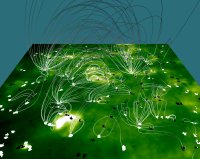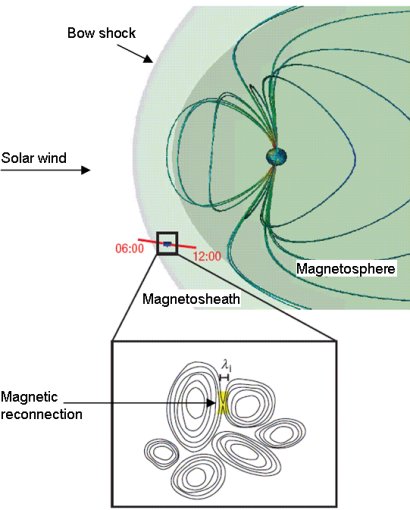First direct evidence in space of magnetic reconnection in turbulent plasma
26 March 2007
Magnetic reconnection is a universal process in space, playing a key role in various astrophysical phenomena such as star formation, solar explosions or the entry of solar material within the Earth's environment. Reconnection has been observed at large-scale boundaries between different plasma environments such as the boundary between Earth and the interplanetary space. Irregular behaviour of particle flows and magnetic fields, known as plasma turbulence, also occur throughout the Universe. In a turbulent plasma many small-scale boundaries can form, where models predict reconnection to occur. However, magnetic reconnection in turbulent plasma has never been directly observed before. Using measurements of the four ESA Cluster satellites, a study published this week in Nature Physics shows, for the first time, experimental evidence of magnetic reconnection in turbulent plasma. This discovery opens new perspectives to better understand the behaviour of turbulent plasmas in the Universe.The Earth's magnetic field is our first line of defence against the permanent flow of particles coming from the Sun: the solar wind. Thanks to the Earth's magnetic field, most of this solar material gets deflected around the Earth's magnetosphere, delimited by a boundary layer called magnetopause.
Like for any other magnetized planet (Jupiter, Saturn, ...), the solar wind is in fact first decelerated from supersonic to subsonic speed by a shock wave (called the bow shock), located in front of the magnetopause. The region between the bow shock and the magnetopause is called the magnetosheath (Image 1). This region is one of the most turbulent environments in the near-Earth space, making it an open-air laboratory to study turbulence. Other environments such as the solar atmosphere or accretion disks are likely to exhibit similar behaviour, but the terrestrial magnetosheath is by far one of the few accessible places to perform in situ measurements. Characterising the properties of the magnetic turbulence in this region is of prime importance to understand its role in fundamental processes such as energy dissipation and particle acceleration.
Magnetic reconnection is a process where the energy stored in magnetic fields is converted into kinetic and thermal energy of a plasma. While magnetic reconnection has been directly observed at large-scale boundaries such as the Earth's magnetopause or in the solar wind, no observations of reconnection at small-scale boundaries (which form in a turbulent plasma) have been reported so far. In space, this requires simultaneous measurements by at least four spacecraft flying in close formation. However, models and numerical simulations have predicted this possibility.
For the first time ever, direct evidence of magnetic reconnection in turbulent plasma is reported, in this week's edition of Nature Physics. This study is based on data collected by the four satellites composing the European Space Agency (ESA) Cluster mission. On 27 March 2002, the Cluster satellites were crossing the magnetosheath with an inter-spacecraft distance of only 100 km. Reconnection was found within a very thin current sheet embedded in the turbulent plasma with a typical size of about 100 km (Image 1), a real challenge for the instruments onboard Cluster. The observations show that the turbulent plasma is accelerated and heated during the reconnection process. Moreover, this new type of small-scale reconnection seems to be associated with the acceleration of particles to energies much higher than their average energy, something which could explain, in part, the creation of high energy particles by the Sun.
"Reconnection in such an environment of irregular magnetic fields could be thought to be sporadic, but this is not the case. For this particular magnetosheath crossing, a very large number of other thin current sheets was found where reconnection is very likely to occur, a subject currently under investigation by our team," says Alessandro Retinò lead author of this study, PhD student at the Swedish Institute of Space Physics, Uppsala, Sweden.
 |
|
| Animation 1. ESA/NASA SOHO satellite observation of on active region with loops and X-type solar flare by the EIT instrument 195Å in November 1997. (For larger versions of this video click here) | Image 2. Model of magnetic fields at the Sun's surface using SOHO data from several instruments taken on 19 October 1996. |
The discovery of reconnection in turbulent plasma has significant implications for the study of laboratory and astrophysical plasmas, where both turbulence and reconnection naturally develop and thus where turbulent reconnection is very likely to occur. Possible applications range from the dissipation of magnetic energy in fusion devices on Earth to the acceleration of high energy particles in solar explosions called solar flares (Animation 1 and Image 2).
"Magnetic reconnection, turbulence and shocks are three fundamental ingredients of the plasma Universe. The detailed understanding of these key processes and their associated multi-scale physics is a challenge for the future of space physics. One of the lessons learned from the Cluster mission is the need for new space missions equipped with instruments of higher sensitivity and better time resolution together with a larger number of satellites," says Philippe Escoubet Cluster and Double Star project scientist at ESA.
Retinò, A., D. Sundkvist, A. Vaivads, F. Mozer, M. André and C. J. Owen, In situ evidence of magnetic reconnection in turbulent plasma, Nature Physics, doi:10.1038/nphys574, 25 March 2007.
Contact
Main author
Alessandro Retinò, Swedish Institute of Space Physics and Department of Astronomy and Space Physics, SE-75121, Uppsala, Sweden
Email: Alessandro.Retino irfu.se
irfu.se
Phone: +46-18-4713106
Web story authors
Alessandro Retinò
Arnaud Masson, SCI-SO division, RSSD/ESA, The Netherlands
Email: Arnaud.Masson esa.int
esa.int
Phone: +31-71-565-5634
Web story editors
Philippe Escoubet, SCI-SM division RSSD, ESA, The Netherlands
Email: Philippe.Escoubet esa.int
esa.int
Phone: +31-71-565-4564
Arnaud Masson
Matthew Taylor, SCI-SO division, RSSD, ESA, The Netherlands
Email: Matthew.Taylor esa.int
esa.int
Phone: +31-71-565-8009



